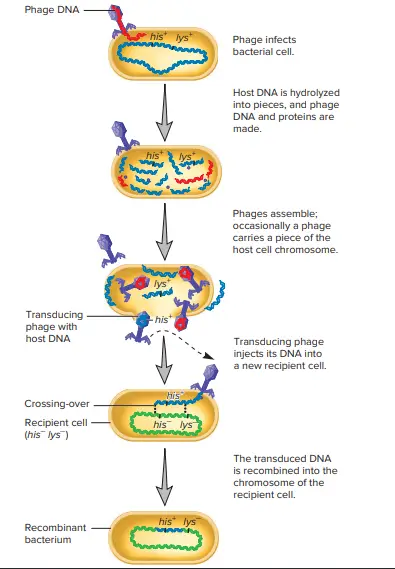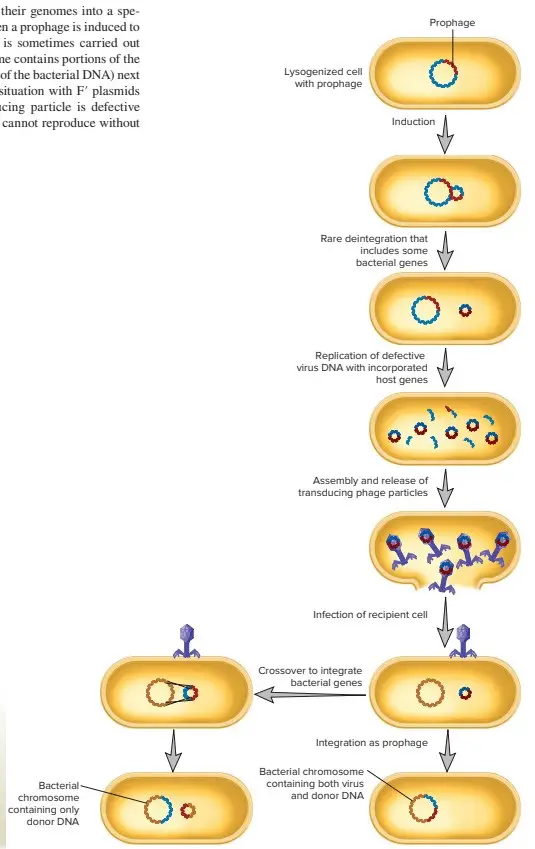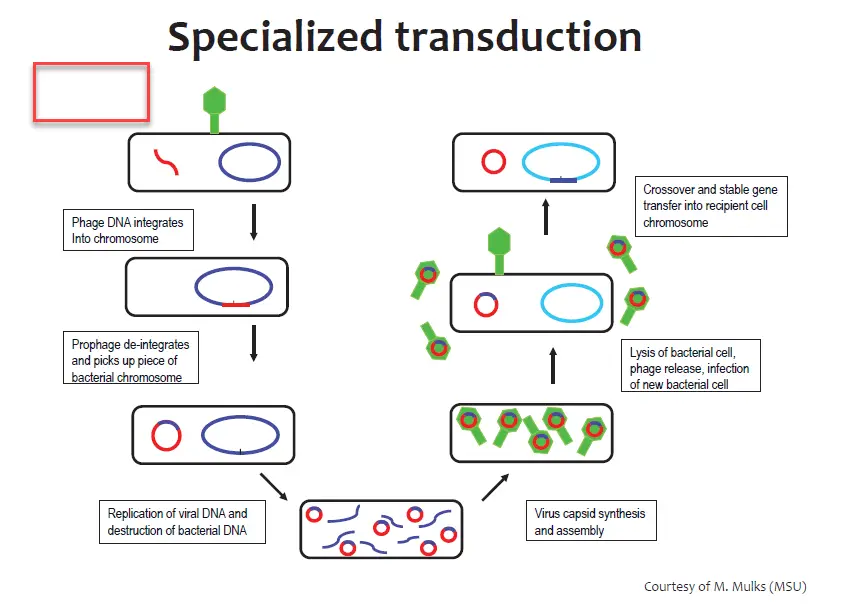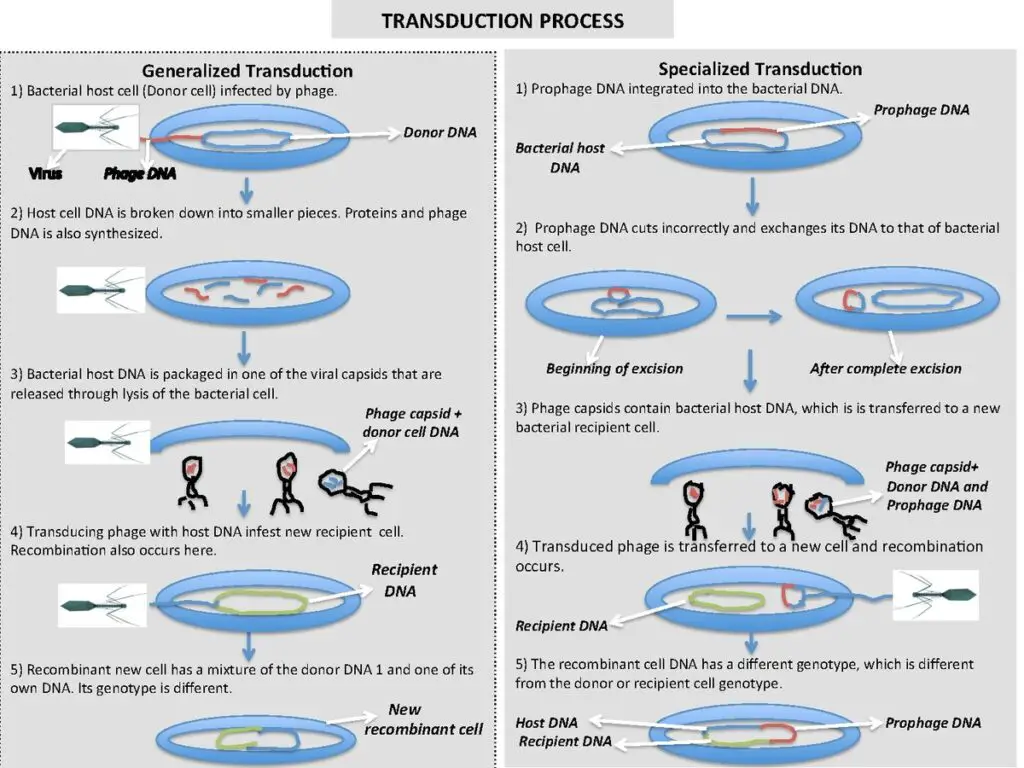Table of Contents
Viruses play a role in transduction. It is a common mode of HGT in the natural world. In fact, evidence indicates that the number of genes transferred by marine viruses from one host cell to another is enormous (approximately 1024 per year). In addition, viruses in marine environments and hot springs transfer genes among organisms from all three domains of life. Recall from chapter 6 that virus particles are structurally basic, typically consisting of a nucleic acid genome surrounded by a protein coat known as the capsid. Viruses are incapable of self-replication. Instead, they infect and seize control of a host cell, compelling it to produce numerous viral copies. Viruses that infect microorganisms are known as phages, or bacteriophages. Immediately upon entrance, virulent bacteriophages multiply within their bacterial host.
Once the number of progeny phage particles reaches a certain threshold, they cause the host to lyse so that they can be released and infect new host cells. Consequently, this process is known as the lytic cycle. In contrast, temperate bacteriophages do not promptly kill their host. Instead, the phage forms a relationship with its host known as lysogeny; bacteria that have been lysogenized are known as lysogens. Numerous temperate phages induce lysogeny by inserting their genomes into the bacterial chromosome. A prophage is the viral genome that has been deposited.
This does not damage the host bacterium, and the phage genome replicates alongside the host cell’s genome. The inactivity of temperate phages in their hosts can persist for many generations. Under particular conditions, including UV irradiation, they can be induced to transition to a lytic cycle. The prophage is then removed from the bacterial genome, and the lytic cycle continues. Transfer of bacterial or archaeal genes by virus particles is known as transduction. It is essential to comprehend that host genes are packaged within the virus particle due to errors that occurred during the virus’s life cycle. The virion transports these genes to a new cell. There have been described two types of transduction: generalized and specialized.
Bacterial Transduction Definition – What is transduction?
- Transduction refers to the transfer of a part of DNA between two bacteriums via a bacteriaophage.
- Transduction is mediated by viruses.
- During the replication of virus in a cell, a small piece of bacterial DNA gets incorporated into the bacteriophage. This DNA is then transferred to the recipient bacteria at the time of infection.
- Through a process known lysogenic conversion, the phage DNA from the recipient bacterial cell is integrated into the cell DNA.
- Lysogenic transformation confers a new property on the bacterial cell. For example, nonpathogenic bacteria may become pathogenic through lysogenic convert.
- Bacteriophages can encode diphtheria, botulinum, cholera, and erythrogenic toxins from one bacterium, via transduction.
- Bacteria infecting viruses are known by the shorthand bacteriophages (or phages).
- Virulent bacteriophages multiply within their bacterial host as soon as they enter. After the progeny-phage particles have reached a certain amount, they cause the host’s cells to lyse. This allows them to be released and infect other host cells. This process is called the “lytic cycle”.
- Temperate bacteriaophages, however, don’t kill their host right away. Instead, the host establishes a relationship called lysogeny with the phage. Lysogenized bacteria are also known as lysogens.
- Many temperate Phage species establish lysogeny via inserting their genomes into a bacterial chromosome. Prophages are the viral genome that is inserted into the host bacterium. This is not harmful to the host bacterium and the phage gene is copied along with the genome of the host cell.
- Temperate phages might remain inactive for several generations in their hosts. Under certain conditions, such as UV radiation, they can be made to switch to the lytic cycle. Once this happens, the prophage from the bacteria genome is removed and the lytic cycles proceeds.
Principle of Bacterial Transduction
During transduction, the DNA of the bacterial donor is assimilated into the bacteriophage during either the lytic or lysogenic cycle. The newly formed phages are subsequently released from the bacterial cell and infect a host bacterial cell. The phages attach to a specific receptor on the bacterial cell’s surface and introduce their DNA, which contains the donor DNA, into the cytoplasm of the host cell. The DNA may integrate into the bacterial genome, replicate as a plasmid in the cytoplasm, or replicate immediately to produce phage progeny, depending on the type of phage.
Bacterial transduction steps and Classification/Types
Two types of transduction exist:
- Generalized transduction.
- Specialized transduction.
A. Generalized Transduction Transfers – Any Donor Gene
- Generally speaking, generalized transduction occurs during the lytic cycle of virulent phages, but it can also occur during the lytic cycle of temperate phages.
- As the virus seizes control of its host, any portion of the bacterial genome can be conveyed after being partially degraded.
- During the assembly stage, viral genomes are packaged using the “headful mechanism”; that is, only genomes of a certain size (i.e., number of nucleotides) are packaged. A fragment of the host genome that is roughly the same size as the phage genome is mistakenly packaged during generalized transduction.
- This type of phage is known as a generalized transducing particle because, once released, it can encounter a susceptible host cell and transfer the bacterial DNA it transports into that cell. Due to the absence of viral genes, this does not initiate the lytic cycle.
- As with transformation, the DNA fragment must be incorporated into the chromosome of the recipient cell to preserve the transferred genes. During transfer, the DNA remains double-stranded, and both strands are incorporated into the recipient’s chromosome.
- Seventy to ninety percent of transferred DNA is not integrated but can frequently remain intact and be expressed. Abortive transductants are bacteria that possess non-integrated, transduced DNA and are therefore partial diploids.
Steps of Generalized Transduction
- The phage first infects the phage host cell (donor cell), during which the phage DNA penetrates the cytoplasm of the bacteria.
- During the lytic cycle of viral replication, both the phage DNA and the bacterial chromosome are fragmented into smaller fragments.
- Upon lysis of the bacterium, a portion of the bacterial chromosome is then incorporated into one of the viral capsids.
- The transducing phase with the bacterial chromosome now infects a second bacterium (recipient bacterium), and donor DNA enters the second bacterium’s cytoplasm.
- In the presence of the host recombinase recA, donor DNA recombines with the recipient’s homologous DNA to produce stable transductants.

Note: The recombinant bacterium has a genotype (his+ lys- ) that is dierent from recipient bacterial cell (his- lys-).
Types of Generalized transduction
Generalized transduction may be complete or abortive:
Complete transduction
- Complete transduction is characterized by production of stable recombinants that inherit donor genes and retain the ability to express them.
Abortive transduction
- Abortive Transduction refers to transient expression of one or several donor genes without the formation of recombinant material.
- The donor DNA fragment is not replicable in abortive transcription, and only one bacterium has the donor DNA segment among the progeny.
- After each generation of bacterial proliferation, the donor genes products are gradually diluted in other progeny until the donor phenotype is no longer expressed.
- Selective medium allows abortive transductants to produce small colonies that can easily be distinguished from stable transductants.
- The frequency of abortive transmission is usually one to twofold higher than that of generalized transcription. This shows that cells infected by generalized phages are not capable of producing recombinant geny.
B. Specialized Transduction Transfers – Specific Donor Genes
- In specialized transduction, transducing particles carry only specific portions of the bacterial genome. An defect in the lysogenic life cycle of temperate phages that insert their genomes into a specific site on the host chromosome enables specialized transduction.
- When a prophage is induced to depart its host chromosome, excision is occasionally performed incorrectly. Similar to the situation with F′ plasmids, the resultant phage genome contains 5 to 10 percent of the bacterial chromosome adjacent to the integration site.
- However, the transducing particle is defective because it lacks viral genes and therefore cannot reproduce independently. Despite this, it injects the remaining viral genome as well as any bacterial genes it transports into another bacterium.
- Under the right conditions, the bacterial genomes may become permanently integrated. E. coli phage lambda is the most thoroughly investigated example of specialized transduction.
- At specific locations known as attachment or att sites, the lambda genome integrates into the host chromosome. Phage att sites and bacterial att sites are comparable and can form complexes.
- The att site for lambda is located between the gal and bio genes on the E. coli chromosome; consequently, these bacterial genes are frequently present when lambda excises incorrectly to generate a specialized transducing particle.
- The product of cell lysis (lysate) resulting from the induction of a population of lysogenized E. coli cells contains normal phage and a few defective transducing particles.

Example of Specialized transduction
- The E. coli phage bacterium lambda is the most well-studied example specialized transduction.
- The lambda gene inserts into the host’s chromosome in specific locations called attachment or att spots.
- The bacterial and phage att site are very similar and can interact with each other.
- The att site of lambda lies between the bio and gal genes on the E.coli chromosome. This means that when lambda excises incorrectly, these bacterial genetics are most commonly present.
- The cell lysis product (lysate), which results from induction of a number of lysogenized E. coli bacteria cells, contains normal phage as well as a few defective transducing particle.
- These particles are called lambda gal if they possess the galactose usage genes, or lambda biif they have bio from the opposite side of the att.
The Mechanism of Transduction for Phage Lambda and E. coli.
Between the gal and bio genes is integrated lambda-phage. If it excites normally (top left), then the new phage contains no bacterial gene and is complete. Rarely, the excision is done asymmetrically (top center), meaning that either the gal gene or bio genes are taken up and some phage genetics are lost. The gal genes are the only exception to this rule. A defective lambdaphage is created that carries bacterial genetics and can transfer them onto a new recipient.

Steps of Specialized transduction
- During the lysogenic cycle, the phage DNA is integrated into the bacterial chromosome following bacteriophage infection of the donor bacterium.
- As a result of the imprecise severing of phage DNA, a portion of the bacterial chromosome is also removed.
- The phage containing a portion of the bacterial chromosome then infects a new host, and during the lysogenic cycle of replication, the donor DNA is incorporated into the recipient bacterium.
- The recipient then displays the newly acquired genetic characteristic.

Differences between Generalized vs Specialized transduction
Specialized Transduction | Generalized Transduction | |
|---|---|---|
| DNA Source | Specific region adjacent to prophage | Random fragments from bacterial genome |
| Frequency | Low | Relatively higher |
| Transfer Mechanism | Excision of prophage with nearby DNA | Mistaken packaging during phage assembly |
| Transfer Range | Limited to specific genes or loci | Any segment of the bacterial genome |
| Recipient Specificity | Closely related strains with shared site | Less specific, between different strains |
| Genetic Mapping | Useful for precise genetic mapping | Less suitable for precise mapping studies |

Differences between Transduction vs Transfection
Transduction | Transfection | |
|---|---|---|
| Mechanism | Mediated by bacteriophages | Mediated by artificial methods (e.g., liposomes, electroporation) |
| Genetic Material | Bacterial DNA transferred to another bacterium | Exogenous DNA (e.g., plasmid, siRNA) transferred to eukaryotic cells |
| Host Range | Bacterial cells | Eukaryotic cells |
| Methodology | Infection by bacteriophages | Introduction of exogenous DNA into cells |
| Natural Process | Yes | No |
| Delivery Efficiency | Efficient | Variable, dependent on the method used |
| Genetic Modification | Can transfer specific DNA fragments or genes | Can introduce specific genes or manipulate gene expression |
| Applications | Genetic mapping, gene transfer in bacteria | Gene expression studies, gene therapy, cell line generation, functional studies |
Differences between Transduction vs Transformation
Transduction | Transformation | |
|---|---|---|
| Mechanism | Mediated by bacteriophages | Uptake of exogenous DNA by recipient cells |
| Genetic Material | Bacterial DNA transferred to another bacterium | Exogenous DNA (e.g., plasmid) taken up by recipient cells |
| Methodology | Infection by bacteriophages | Uptake of DNA through physical or chemical methods |
| Natural Process | Yes | No |
| Host Range | Bacterial cells | Bacterial, yeast, plant, and animal cells |
| DNA Source | Donor bacterium | External DNA source (e.g., plasmid) |
| Genetic Modification | Can transfer specific DNA fragments or genes | Can introduce specific genes or manipulate gene expression |
| Efficiency | Can occur at low frequencies | Dependent on the recipient cell and method |
| Applications | Genetic mapping, gene transfer in bacteria | Genetic engineering, creation of transgenic organisms, gene expression studies |
Differences between Transduction vs Conjugation
| Transduction | Conjugation | |
|---|---|---|
| Mechanism | Mediated by bacteriophages | Direct cell-to-cell contact via conjugative plasmids |
| Genetic Material | Bacterial DNA transferred to another bacterium | Transfer of plasmid DNA between bacteria |
| Transfer Mechanism | DNA is packaged in bacteriophages and delivered to recipient cells | Plasmid DNA is transferred through a conjugation bridge |
| Natural Process | Yes | Yes |
| Host Range | Bacterial cells | Bacterial cells |
| DNA Source | Donor bacterium | Donor bacterium carrying conjugative plasmid |
| Type of DNA Transfer | Transfer of random DNA fragments | Transfer of entire plasmids |
| Genetic Modification | Can transfer specific DNA fragments or genes | Can transfer entire plasmids and associated genes |
| Transfer Efficiency | Less efficient compared to conjugation | Efficient in transferring plasmids between bacteria |
| Selectivity | Can transfer DNA to various bacterial strains | Can be selective for specific bacterial strains based on compatibility |
| Applications | Genetic mapping, gene transfer in bacteria | Horizontal gene transfer, spread of antibiotic resistance, genetic engineering |
Differences between Transduction vs Transmission
Transduction | Transmission | |
|---|---|---|
| Definition | Process of DNA transfer mediated by bacteriophages | Process of disease or pathogen spread from one host to another |
| Biological Context | Occurs in bacteria | Occurs in various organisms (e.g., animals, plants, humans) |
| Genetic Material | Transfer of bacterial DNA fragments | Transfer of pathogen DNA or entire infectious agents |
| Mechanism | Mediated by bacteriophages | Mediated by various modes (e.g., direct contact, respiratory droplets, vectors) |
| Transfer Route | Within bacterial populations | Between hosts or individuals |
| Host Range | Bacterial cells | Various organisms depending on the specific disease or pathogen |
| Nature | Can occur naturally or in laboratory settings | Natural occurrence in infectious diseases |
| Examples | Transduction in bacterial populations | Transmission of viruses, bacteria, parasites, etc. in infectious diseases |
| Factors Affecting | Bacterial phage-host interactions, frequency of infection | Mode of transmission, environmental factors, host susceptibility |
| Control Measures | Understanding and manipulating phage interactions in bacterial populations | Public health interventions, vaccinations, vector control, hygiene practices |
Transduction example
An example of transduction is the transfer of antibiotic resistance genes between bacteria. Let’s consider a scenario where a donor bacterium carries a plasmid that encodes antibiotic resistance, while a recipient bacterium is susceptible to that particular antibiotic.
- In the environment, a bacteriophage (transducing phage) infects the donor bacterium, which contains the antibiotic resistance plasmid.
- During the assembly of new phage particles, some fragments of the bacterial DNA, including the antibiotic resistance gene, are mistakenly packaged into the phage capsid.
- The donor bacterium is lysed or undergoes a lytic cycle, releasing phage particles carrying the bacterial DNA fragments.
- The phage particles, now carrying the antibiotic resistance gene, come into contact with the recipient bacterium of the same species.
- The phage attaches to the surface of the recipient bacterium and injects its genetic material, including the antibiotic resistance gene, into the recipient’s cytoplasm.
- The transferred antibiotic resistance gene integrates into the recipient bacterium’s genome, conferring resistance to the antibiotic.
- The recipient bacterium, now carrying the antibiotic resistance gene, can proliferate and pass on the resistance trait to its progeny through subsequent cell divisions.
This example illustrates how transduction can facilitate the transfer of genetic material, such as antibiotic resistance genes, between bacteria, contributing to the spread of antibiotic resistance in bacterial populations.
Application of Transduction
Transduction has numerous applications in molecular biology and biotechnology, both generalised and specialised. Here are some prominent transduction applications:
- Genetic Mapping: Transduction can be used for genetic mapping, which is the process of establishing the relative locations of genes on a chromosome. Researchers can deduce the order and distance between genetic markers by analysing the frequency of transduction events, providing vital insights into the organisation of the bacterial genome.
- Gene Transfer and Genetic Engineering: In bacteria, transduction can be used for gene transfer and genetic engineering. Specific genes of interest can be introduced into recipient bacteria using transducing phages, allowing for the transfer of desired features or the study of gene function. This technique is very beneficial when working with bacteria that are difficult to transform using other methods, such as some strains lacking inherent competence.
- Gene Therapy:Transduction has the potential to be used in gene therapy, a science that aims to correct genetic problems by delivering functional genes into target cells. Researchers are investigating the use of viral vectors, such as bacteriophages, to deliver therapeutic genes into specific cells or tissues by utilising the transduction process. This method has promise for treating a variety of hereditary illnesses.
- Antibiotic Resistance Research: Transduction is critical in understanding the distribution of antibiotic resistance genes among bacteria. Resistance genes can be transferred from antibiotic-resistant bacteria to susceptible strains via transduction, allowing researchers to study the mechanisms of resistance acquisition as well as the dynamics of resistance dissemination in microbial communities.
- Bacterial Evolution and Horizontal Gene Transfer: Transduction is an important mechanism that promotes bacterial evolution via horizontal gene transfer. It enables the transfer of genetic material, including advantageous features, between bacterial species or strains. Understanding transduction pathways aids in the study of bacterial pathogen evolution, virulence factor acquisition, and antibiotic resistance development.
- Phage Therapy: Transduction is important in phage therapy, which uses bacteriophages to combat bacterial illnesses. Specific genes or genetic components that provide antibacterial qualities can be transferred to pathogenic bacteria using phages’ natural transducing capabilities, potentially increasing the phage’s efficacy in killing the target pathogens.
These applications show how transduction can be used in a variety of domains, ranging from genetic research and engineering to medical interventions and studying the dynamics of bacterial populations.
FAQ
What is bacterial transduction?
Transduction is the process by which a virus transfers genetic material from one bacterium to another. Viruses called bacteriophages are able to infect bacterial cells and use them as hosts to make more viruses.
bacterial transduction begins when a kind of virus called a —-
A bacteriophage is: a virus that infects bacteria.
How does transduction differ from other modes of genetic transfer in bacteria?
Transduction differs from other modes of genetic transfer, such as conjugation and transformation, as it involves the transfer of DNA mediated by bacteriophages.
What are the types of transduction?
There are two types of transduction: generalized transduction and specialized transduction. Generalized transduction involves the random transfer of any bacterial DNA, while specialized transduction involves the transfer of specific DNA sequences adjacent to the integrated prophage.
What is the role of bacteriophages in transduction?
Bacteriophages serve as vehicles for the transfer of bacterial DNA during transduction. They infect bacterial cells, acquire fragments of bacterial DNA, and then deliver this DNA to recipient bacteria.
How does generalized transduction occur?
In generalized transduction, during the lytic cycle of bacteriophage replication, random bacterial DNA fragments are mistakenly packaged into newly formed phage particles. These phage particles then infect other bacteria, transferring the bacterial DNA.
How does specialized transduction occur?
Specialized transduction occurs when a prophage (integrated phage genome) excises from the bacterial chromosome but carries adjacent bacterial DNA along with it. This excised prophage, now containing bacterial DNA, infects other bacteria and transfers the specific DNA sequences.
What is the significance of transduction in bacterial evolution?
Transduction plays a crucial role in bacterial evolution by facilitating the transfer of genetic material, including beneficial traits and antibiotic resistance genes, between bacterial strains or species.
Can transduction transfer specific genes or genetic markers?
Yes, transduction can transfer specific genes or genetic markers depending on the type of transduction. Specialized transduction can transfer specific DNA sequences adjacent to the integrated prophage, while generalized transduction can transfer random DNA fragments.
How is transduction different from horizontal gene transfer?
Transduction is one mechanism of horizontal gene transfer, which refers to the transfer of genetic material between organisms of the same generation. Transduction specifically involves the transfer of bacterial DNA via bacteriophages.
What are the applications of transduction in research and biotechnology?
Transduction has various applications in genetic research, including genetic mapping, gene transfer, and studying antibiotic resistance. It is also utilized in biotechnology for genetic engineering, gene therapy, and the creation of transgenic organisms.
References
- https://en.wikipedia.org/wiki/Transduction_(genetics)
- https://www.nature.com/scitable/definition/transduction-prokaryotes-292/
- https://www.britannica.com/science/transduction-microbiology
- https://study.com/academy/lesson/bacterial-transduction-definition-process-advantages.html
- https://www.khanacademy.org/science/ap-biology/gene-expression-and-regulation/mutations-ap/a/genetic-variation-in-prokaryotes
- https://www.slideshare.net/8988337117/vikas-pathania
- https://www.vedantu.com/biology/transduction-microbiology
- https://www.bioexplorer.net/bacterial-transduction.html/
- https://blog.addgene.org/plasmids-101-transformation-transduction-bacterial-conjugation-and-transfection


